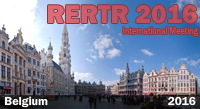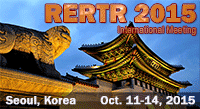 2006 International RERTR Meeting
2006 International RERTR Meeting
Abstracts and Available Papers Presented at the Meeting
Advanced Test Reactor LEU Fuel Conversion Feasibility Study Annual 2006 Report
G. S. Chang, R. G.
Ambrosek (retired), and M. A. Lillo
Idaho National Laboratory
Idaho Falls, Idaho 83415 - United States
ABSTRACT
The Advanced Test Reactor (ATR) is a high power density and high neutron flux research reactor operating in the United States. Powered with highly enriched uranium (HEU), the ATR has a maximum thermal power rating of 250 MWth with a maximum unperturbed thermal neutron flux rating of 1.0 x 1015 n/cm2-s. Because of these operating parameters and large test volumes located in high flux areas, the ATR is an ideal candidate for assessing the feasibility of converting an HEU driven reactor to a low-enriched core. The present work investigates the necessary modifications and evaluates the subsequent operating effects of this conversion.
A detailed plate-by-plate MCNP ATR 1/8th core model was developed and validated for a fuel cycle burnup comparison analysis. Using the current HEU U-235 enrichment of 93.0 % as a baseline, an analysis can be performed to determine the low-enriched uranium (LEU) density and U-235 enrichment required in the fuel meat to yield an equivalent K-eff between the HEU core and the LEU core versus effective full power days (EFPD). The MCNP ATR 1/8th core model will be used to optimize the U-235 loading in the LEU core, such that the differences in K-eff and heat profile between the HEU and LEU core can be minimized for operation at 125 EFPD with a total core power of 115 MW.
The depletion methodology MCWO, was used to calculate K-eff versus EFPDs. The MCWO-calculated results for the LEU case demonstrated adequate excess reactivity such that the K-eff versus EFPDs plot is similar in shape to the reference ATR HEU case. The LEU core conversion feasibility study can also be used to optimize the U-235 content of each fuel plate, so that the relative radial fission heat flux profile is bounded by the reference ATR HEU case. The detailed radial, axial, and azimuthal heat flux profiles of the HEU and optimized LEU cases have been investigated. However, to demonstrate that the LEU core fuel cycle performance can meet the UFSAR safety requirements, additional studies will be necessary to evaluate and compare safety parameters such as void reactivity and Doppler coefficients, control components worth (outer shim control cylinders (OSCCs), safety rods and regulating rod), and shutdown margins between the HEU and LEU cores.
![]() Full paper in PDF format
Full paper in PDF format
- Advanced Test
Reactor LEU Fuel Conversion Feasibility Study Annual
2006 Report,
G. S. Chang et al.
[PDF, 276KB, 13 pages]
IMPORTANT NOTE:
Download the latest and free version of
Adobe's
Reader to view documents in PDF format. If you have questions about
or problems with downloading, installing or using Adobe's Reader, please visit the
Adobe
website.
![]()
Problems viewing/ printing PDF files
Should you experience problems with viewing/printing the PDF files:
![]() PDF Help Notes (link opens in new browser
window)
PDF Help Notes (link opens in new browser
window)
Contact:
Dr. Jordi Roglans-Ribas
Technical Director, RERTR Department
Nuclear Engineering Division – 362
Argonne National Laboratory
9700 South Cass Avenue
Argonne, IL 60439
Fax: +1 630-252-5161
![]()




